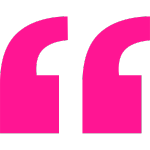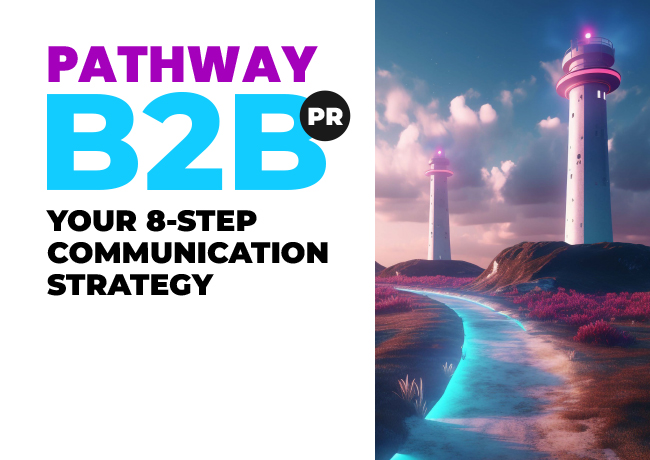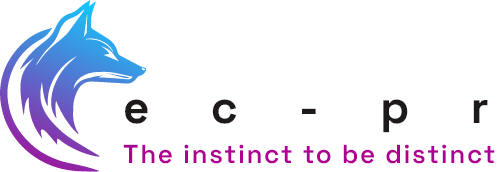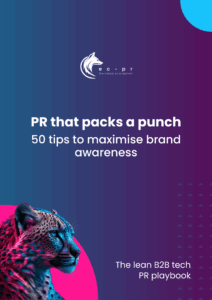
8 simple steps to an effective B2B communication strategy for 2025
How to build a B2B communication strategy that works
A strong B2B communication strategy differentiates your brand, ensuring clear, persuasive messaging. After years of helping brands craft impactful messaging, we’ve uncovered a common mistake—many businesses focus on PR tactics without a clear strategy. Our case studies show that companies which follow a structured approach see measurable growth in brand awareness, competitive positioning, and sales. But it’s not about generic messaging—it’s about precision. In this article, we lay out 8 key components to help you build a truly effective B2B communication strategy
Did you know that 68% of buyers say B2B brands all sound the same? In today’s fast-changing B2B sector, having a strong communication strategy is what helps your brand stand out, ensuring you’re not just seen—but remembered.
Your communication strategy defines how you’re going to communicate in a way that will make your brand memorable, persuasive, and credible to your target buyer – at every stage of the buyer’s journey. It defines what you’re going to say and to whom, where, and when you’re going to say it. More importantly, it’s supported by robust evidence and customer insight.
If you want to increase your brand awareness, strengthen your competitive position, command share of voice and accelerate sales – you need a communication strategy.
Why does your business need a communication strategy?
The foundation of every effective branding, marketing, or public relations brief should be found in the communication strategy – without this, you’re likely to end up wielding a blunt instrument and wasting money.
Many of EC-PR’s case studies showcase how a strong communications strategy can supercharge your business. For instance, just three months after launching their new strategy, 2i—an Edinburgh-based consultancy specialising in assurance and testing services— saw measurable success in at least 18 different ways, including securing new clients.
What are the key components of a communication strategy?
The three critical components of a communication strategy are the value proposition, which is your cornerstone, your target personas and your key messaging. However, to be truly effective, you need to consider all five elements of the communication strategy as essential and reliant upon each other.
- Value proposition
- Sector priorities
- Target personas
- Positioning statements
- Messaging (for each stage of the buying cycle)
If one or more of the elements is poorly developed or missing, your strategy will be less effective and impactful.
What are the 8 essential steps to creating a communication strategy for your business?
The five components require eight important steps to achieve the ideal outcome. In this section, we walk you through the process of producing a communication strategy for your technology business.

Form the dream team:
Ensure you get the right people involved, so that your communication strategy will have the insight, expertise and gravitas that it needs.

Value proposition:
Your value proposition is a simple statement to summarise your promise to your customers

Target audience:
A target persona is a representation of your ideal customer. They’re not real people bu they should be brought to life as much as possible.

Messaging:
Messaging should take into account your customers’ wants and needs at each stage of the buying cycle.

Objective setting:
What should marketing deliver, in order for the company to acheive its strategic goal.

Prioritise your audience:
Unless you have an infinite supply of resources (mainly money and time), you’ll need to reprioritise.

Positioning statement:
A positioning statement is a subset of your value proposition but speaks directly to your individual personas.

Validation:
Validate assumptions with trusted customers & advisors. Refine your strategy with their feedback.

Form the dream team:
Ensure you get the right people involved, so that your communication strategy will have the insight, expertise and gravitas that it needs.

Objective setting:
What should marketing deliver, in order for the company to acheive its strategic goal.

Value proposition:
Your value proposition is a simple statement to summarise your promise to your customers

Prioritise your audience:
Unless you have an infinite supply of resources (mainly money and time), you’ll need to reprioritise.

Target audience:
A target persona is a representation of your ideal customer. They’re not real people bu they should be brought to life as much as possible.

Positioning statement:
A positioning statement is a subset of your value proposition but speaks directly to your individual personas.

Messaging:
Messaging should take into account your customers’ wants and needs at each stage of the buying cycle.

Validation:
Validate assumptions with trusted customers & advisors. Refine your strategy with their feedback.
 The communication strategy development programme EC-PR delivered, returned control and authority to the marketing team
The communication strategy development programme EC-PR delivered, returned control and authority to the marketing team
“We now know exactly what we need to say to support our different target audiences at every stage of the buying cycle. The clarity and structure of the communication strategy, which EC-PR has provided us, has given us the set of tools and the plan we need so that everything we do makes sense.”
Veronica Araujo
Head of Performance Marketing, Informa Connect
1. Form ‘the dream team’:
First and foremost, recruit your expert task force from across the business. Ensure you get the right people on board, so that your communication strategy will have the insight, expertise and gravitas it needs. Customer insight is essential, so unless you have the time and resources to conduct a major piece of qualitative and quantitative research, you must include someone who knows your customers vividly. Your project will also require a board-level champion to embed the new strategy across the business.
2. Define business objectives:
Capture your sales lead requirements and determine what success will look like from a business perspective. What should marketing deliver for the company to achieve its strategic goals? Whatever your objectives are, they must be SMART and there should be a communication objective against each business objective. For example:
To generate #X qualified leads for bespoke vessel design from shipyards servicing the renewables industry.
3. Craft your value proposition:
Your value proposition is a simple statement to summarise your promise to your customers.
It encapsulates the benefits of buying from you, rather than your competitors; why you exist and most importantly, why your customers should care. It should be concise, compelling, and credible. Once crafted, it should be used to guide what everyone in the company from customer service to R&D, says, does and develops, keeping your communications focused and relevant.
4. Prioritise your audience:
Unless you have an infinite supply of resources (mainly money and time), you will need to prioritise. Identifying your target audience’s sweet spot is the most effective way of identifying your low-hanging fruit. Look for overlapping common characteristics to identify groups that form ideal customers – those customers you can help to overcome a key problem or challenge.
5. Define target personas:
A target persona is a representation of your ideal customer. They’re not real people, but you depict them so clearly, they should feel like one. Most people mistakenly think they need to have lots of personas because they try and identify them by job title. You want to focus on decision-makers in the buying process, the people who feel the pain you can solve and, most importantly, have a responsibility for finding a solution. Three is likely to be the number of personas you can realistically engage with effectively through any one campaign. Remember to give your target personas a memorable name that everyone can connect with – I find alliteration helps e.g., Brilliant Belinda, Innovative Ida, Commercial Colin, Financial Fred, Regimental Roy, IT Tom etc.
6. Develop positioning statements:
Craft and tailor a positioning statement for each persona you end up with. A positioning statement is a subset of your value proposition but speaks directly to the heart of your individual persona(s). It defines the target audience, your product and category, a specific benefit and, most importantly, it differentiates you from your nearest competitor. This is particularly important if you have multiple sub-brands or discrete products aimed at different markets.
7. Create a messaging framework:
Develop messaging for each stage of the buying cycle.
The four key stages of the buying cycle (or customer journey) are well documented, with the most common being represented in the acronym AIDA (Awareness, Interest, Desire and Action). It’s imperative that your messaging considers your customers’ journey through these stages, and is specific, relevant and compelling – to tailor to each stage of that journey. The first two stages build trust, whilst the latter two account for the customer’s consideration and desire. These four key stages of messaging need to work in harmony to inspire interest and help convert prospects into customers.
8. Validate and refine your strategy:
Test the assumptions you have made in your draft communication strategy amongst your trusted customers and advisors. You don’t have to share the exact document but do ask intelligent, searching questions around the key components to get their input. Make sure you involve a good mix of different target personas. If you’ve gone through the process thoroughly, you should not be seeking to present their ‘agreement’ – you are looking for refinements, it’s more of an opportunity to validate any assumptions you’ve made. Use their feedback to refine and create your final communication strategy.
How to implement your strategy
Once you have your comprehensive communication strategy, written and approved, take the following steps to implement it!
Share it with the organisation: every department should consider how the strategy impacts their day-to-day activity. Are your sales teams aligned with the value proposition? Are your customer service teams closely familiar with your target personas and their pain points?
Review your existing brand assets: check everything from website to LinkedIn profiles and ensure every message is current and accessible to your target audience.
Plan your campaigns: use your strategy as the foundation to plan future B2B marketing campaigns
If you found this article valuable, you can get more useful insight here. Download our comprehensive guide and share with your team: Your 8 Step Communication Strategy.
And finally our Communication Strategy Case Studies demonstrate the radically successful results an effective b2b communication strategy will produce.
At EC-PR we are passionate about B2B communication. Get in touch with our PR experts to put in place your communication strategy for 2025.

Your 8-Step Communication Strategy Guide
A comprehensive guide to delivering your business goals using intelligent and relevant messaging.
Our insights
Subscribe to our updates
Stay up to date with the latest insights, case studies and PR guides.


